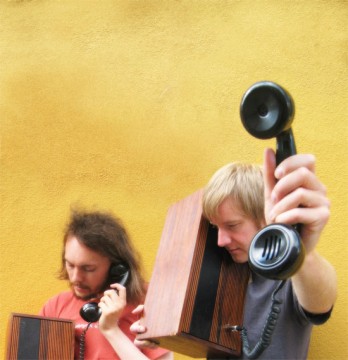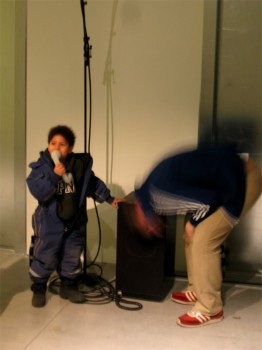Interactivity is the new pink
by Erik Sandelin & Magnus Torstensson, Unsworn
The hosts of Interactivity is the new pink - discussion at experimental interaction day in Nifca, Suomenlinna island, on Saturday 16th, at 16:00-18:00
A year back, we did a lecture at the Interactive Telecommunications Program in New York. We talked about interaction design - as we tend to do. To our surprise this was a concept that a lot of the students there had never heard. They described their work as interactive media design or interactive design.
So, at this year’s Doors of Perception conference in Delhi we kept our ears peeled for the word interactive. This time around we found that neither the word interactive, nor previously omnipresent words such as digital, ubiquitous, pervasive, interface, and intelligent were to be heard. Instead words such as social innovation, local, platforms, infrastructures, collaborative, and sharing were buzzing through the air conditioned hall.
Interactive is a word, an adjective, tightly tied to digital technology roughly meaning capable of acting on or responsive to user activity. The most important clue to the mysterious disappearance of interactive in current colloquy might lie not in the word’s lexical meaning but in its syntactic roles in most sentences: Like other adjectives interactive serves as a modifier of a noun. It describes a quality of a thing and distinguishes it from similar things.
Human language has a tendency, as has our perception, of leaving out the things that are no longer new or important to us. It didn’t take humanity many trips with the electric train or many minutes on the cellular phone to begin referring to them as just trains and phones leaving in the wake neologisms such as steam engine trains, and landline phones. Are we at a similar transition now where the interactive qualities of modern media and systems have become something to which we have grown so accustomed that we no longer feel the need to mention it?
Could it be that we use the word interactive less because we are less concerned with the superficial experiential qualities of the stuff we use and are increasingly eager to find out what we can do with it and what we can do with other people, using it? Could it be that the shift from consumerist dotcom catalactics to participatory dotorg co-creation has left a subtle scar in our professional vernacular?
In the heydays of the dotcom boom designers were occasionally asked to toss some interactivity into a commercial site. Reactive flash movies and image-swapping mouse rollovers were used to convey a modern, state-of the art feel to a site and give the visitor a pleasant, although superficial, experience of not only seeing but also being seen by the high-tech goddess on the other side of the screen. In a way, these dotcom sites offered its visitors some interactivity pretty much the same way most flowers offers the bee some nectar. Interactive was the new pink.
Commissioned to do an interactive sound art piece, the Four Ophones, we found some similar traits and treats within the art world. We found the concepts of the art piece and participation clashing like Kilkenny cats. The traditional piece requires decision, precision, and control while participation calls for openness, ambiguity, and the possibility for misuse. Already half a decade before the heydays of the dotcom frenzy, Brian Eno exclaimed: “The word is out, and the word is wrong.” They say interactive. Unfinished is a better term, according to Eno, to describe how culturemakers are moving away from providing pure, complete experiences to providing the platforms from which people then fashion their own experiences.
Accompanying the disappearance of interactivity, there seems to be a beginning shift also in the conditions of interaction design research. While some major institutional players in the interaction design world, like the Dublin outpost of the MIT Media Lab, are closing down, others are realigning their interests. The studios of the Swedish Interactive Institute are refocusing their themes from being various approaches towards the digital material towards harnessing a wider notion of interactive. It seems that the formerly tight connection between digital media and interactivity is breaking down. New media is getting old. Could it be that the days of material studies are over? If yesteryears focus was on creating new, innovative man-machines interfaces (tangible interfaces, gesture recognition or intelligent devices) today’s innovations with social implications are mostly using existing technologies (think Wikipedia). Perhaps the Big Science of interaction is losing relevance? During the dotorg boom “small is not small” - radical social change is possible even with scarce monetary resources.
So, it seems we will not miss our old friend Interactive. Because we have better words. And, above all, we have better things to do! There is no interactive media, just various materials with special properties and characteristics. There is no interactivity, no property you can add to your artwork/product/system like a colour. There are merely people who interact with each other, in situations where (digital) artefacts and systems sometimes mediate or act as props and catalysts.
So let’s stop sprinkling interactivity, like magic powder, around us and start thinking and acting on the very real consequences of technology. That could lead towards participation that actually means something.
Magnus Torstensson
Magnus Torstensson is an artist, designer, and educator exploring the narrative and psycho-social potential of interactive systems and media.
His work includes tools for sensory relaxation and stimulation for autistic children, interactive sculpture, clothing for urban interventionism, postoptimal electronic attire, and service designs for Telecom Italia and Sony Design Centre London.
Magnus received his MA in Interaction Design from Interaction Design Institute Ivrea as part of the Personal Technologies research group.
Erik Sandelin
Erik Sandelin is an independent interaction designer based in Malmö, Sweden. In his educational, industrial and artistic practice he critically explores the role of increasingly intimate digital technologies in people’s lives and dreams.
Erik has created award-winning work on post-optimal, electronic attire; designed urban interventions; produced interactive sound installations, and hosted workshops on critical fashion design.
Erik holds an MA in Interaction Design from K3, Malmö University in Sweden. He has worked with clients including Sony Ericsson, Swedish Radio, and The Interactive Institute, and has exhibited and performed internationally.
Four Ophones
Four Ophones is an invitation - and an unwritten score - for a composition that lasts as long as the exhibition does. You and other visitors take part as audience, musicians, and cocomposers. No one knows what will happen or how it will sound. Be prepared for everything from subtle interference etudes, to collaborative chanting and big, bad rhythm orgies.
Four Ophones at PixelACHE Exibition in Nifca project space #1 during 14.-17.04.


Friday, April 15th at 6:49 pm
Great article. It is insightful and charming and better language than I often muster.
I will now challenge you on the premise, which I’ll restate: Interactivity is a means to an end. We’re now familiar enough with the means to focus on the ends, i.e. we’re now familiar enough with interactivity that it is an assumption.
But:
I counter that we still need the adjective and the discipline.
We need the adjective because not everything is interactive and it is useful to distinguish what is from what isn’t. We still need to think about it because it is being confused with turn-taking, branching, option-selecting, and even mere reactivity. In the case of Doors, it may just be that the attendees are so immersed that it is a foregone assumption. Surgeons at surgeon conferences don’t need to use the word surgical a lot, I’ll bet. But when they’re out in the world talking to non-surgeons, they might.
We still need the discipline because there is a lot of bad interactivity out there. There are still hours of peoples lives lost, and moments that could be forgotten or enjoyed that are ruined as frustration. We still need the discipline because most products can be interactive and someone has to answer why and how. We still need the discipline because there are people growing up who presume that the current state of things is the natural order, rather than a deliberate construction, full of the problems and consequences and dangers of any human endeavor.
Perhaps what this means is a growing distinction between interaction designers, who are good and studied at thinking in these terms, and artists, for whom it was only a new medium on the way to affecting beauty and change.